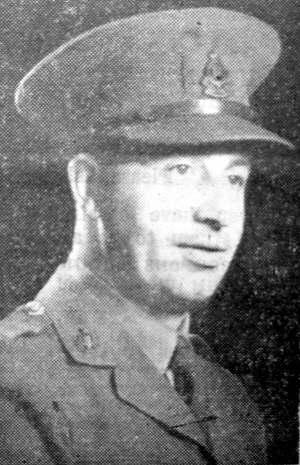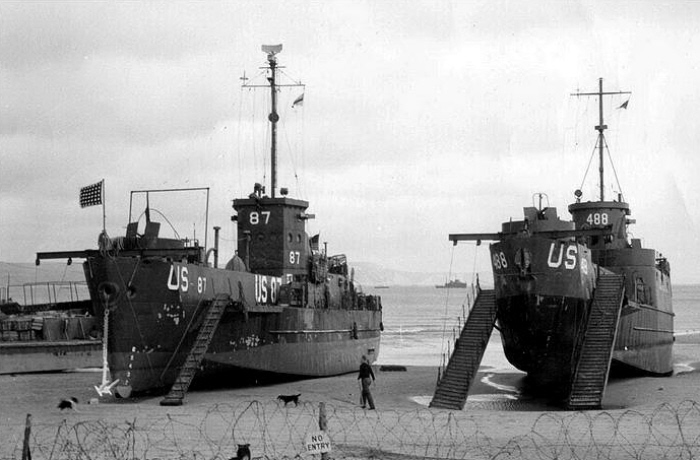
Robert Johnson was born in Summer 1911, the son of innkeeper Reuben Johnson and Annie Jepson, who had married in the Pontefract area in 1892. By 1911, Reuben and Annie were living at the Ring O’ Bells public house, Horbury, where Reuben was the licensee.
The couple had three surviving children by April 1911, having lost one child, and their youngest son, Robert born 1912, was to be their last born child. Reuben Johnson died at Horbury in January 1930, aged 56 years and was buried on the 22nd January 1930 at St. Peter’s & St Leonard’s Church, Horbury.
Robert Johnson married Ethel Widdop, in Ossett in late 1935. Ethel was the youngest of four children of coal miner, Robert Walter Widdop (1877-1911) and Dublin born Alice Emma Green (1884-1944). Robert Johnson and Ethel had one child, Michael Robert Johnson, who was born in 1941.
Robert Johnson of 6, Malvern Road, Dewsbury died on or since 8th June 1944 on war service. Probate was granted at Wakefield on the 6th April 1945, to Arnold Giggal, chartered accountant.
Robert Johnson joined the Army and the Royal Army Ordnance Corps (RAOC) in 1939. The R.A.O.C. dealt only with the supply and maintenance of weaponry, munitions and other military equipment during WW2. Major Robert Johnson was killed in action, in the early hours of June 8th 1944, when the large infantry landing craft LCL-105, that he was travelling to the D-Day Normandy beaches in was hit by a torpedo, launched by a German E-Boat.
The “Ossett Observer” had this obituary for Major Robert Johnson:1
“Missing Officer Presumed Killed – Major R. Johnson, Horbury – About five weeks ago, we announced that Mrs. Ethel Johnson, 6, Malvern Road, off Bywell Road, Dewsbury, had received an official notification that her husband, Major Robert Johnson, Royal Army Ordnance Corps, had been reported missing at sea. Mrs. Johnson has now received a letter from the War Office stating that a full detailed report had now been received of the circumstances in which her husband was reported missing at sea: ‘Major Johnson embarked on June 7th 1944, on a landing craft, which was torpedoed in the early hours of the following morning. The torpedo struck the ship in the aft-cabin, in which unfortunately, Major Johnson and other officers were resting at that time, and it is deeply regretted that, in all circumstances, there can be no room for hope that your husband survived. It is consequently being officially recorded that Major R. Johnson, R.A.O.C. is presumed to have been killed in action at sea o June 8th 1944. I am to convey to you an expression of the sincere sympathy of the Army Council.’
Major Johnson, who was 32 years of age, was a son of the late Mr. Reuben Johnson, for many years the licensee of the Ring-o’-Bells Inn, Horbury. Educated at St. Peter’s Horbury, and Ossett Grammar School, he was articled as an accountant to Mr. Arnold Giggal, Ossett, and later became the secretary of the Associated Companies (Hemingway Furnishers Ltd.), Grand Arcade, Leeds. He joined up with the R.A.O.C. in 1939, and served in France, being one of the last batch to be evacuated. His promotion was rapid, and on returning from France, he was posted to a very responsible position at Donnington. He held the rank of regimental sergeant-major for some time, subsequently receiving a commission as second-lieutenant, afterwards becoming captain and then major. Whilst at Ossett Grammar School he played soccer with the school team, and developed into a skilful exponent, to such an extent that, a few years ago, he received an invitation to sign on for Aston Villa, but declined due to business reasons. He was also a very fine swimmer.
He was very well-known in Ossett and Horbury, and was much esteemed in the district. His wife Ethel, (nee Widdop) an Ossett Grammar School girl, is a daughter of Mrs. Gill, Park Hotel, Park Square, Ossett (by first marriage). The deepest sympathy with Mrs. Johnson and her three year-old son in their loss.”
As with most Armed Forces Serving Personnel during the conflict of World War Two, Major Robert Johnson was entitled to the War Medal 1939-1945. This medal was awarded to all full time service personnel who had completed 28 days service between 3rd September 1939 and the 2nd September 1945. Eligible personnel, like Major Johnson, who had been “Mentioned In Despatches” during the War were entitled to wear a bronze oak leaf emblem on the ribbon. Those eligible for a campaign star, yet who had their service cut short by death, wounds or capture by the enemy, still qualified for this medal.
Major Robert Johnson was also awarded the 1939-45 Star for operational Service in the Second World War between 3rd September 1939, and 2nd September 1945.
Robert Johnson died on the 8th June 1944 aged 32 years and is remembered on Panel 18, Column 3 of the Bayeux Memorial. The town of Bayeux, in Normandy, lies 30 kilometres north-west of Caen. The Bayeux Memorial is situated in the south-western outskirts of the town.
The Allied offensive in north-western Europe began with the Normandy landings of 6 June 1944. The Bayeux Memorial stands opposite the cemetery and bears the names of more than 1,800 men of the Commonwealth land forces who died in the early stages of the campaign and have no known grave. They died during the landings in Normandy, during the intense fighting in Normandy itself, and during the advance to the River Seine in August.
There was little actual fighting in Bayeux although it was the first French town of importance to be liberated. Bayeux War Cemetery is the largest Commonwealth cemetery of the Second World War in France and contains burials brought in from the surrounding districts and from hospitals that were located nearby.
The cemetery contains 4,144 Commonwealth burials of the Second World War, 338 of them unidentified. There are also 505 war graves of other nationalities, the majority German.

Above: Two Landing Craft Infantry (Large) or LCI(L) on the Normandy beach. These vessels are identical to LCI-105 that was torpedoed on the 8th June 1944, during Operation Neptune, which was after the initial D-Day landings. The Landing Craft Infantry was an attack ship in the second line of assault. When the first wave of men from the landing boats had secured the beach, then the reinforcements in big numbers was essential. For this purpose the LCI was developed. The ship could hold 150 to 200 men. Those left the ship by the on both sides placed debarking ramps.
References:
1. “Ossett Observer”, Saturday 29th July 1944.